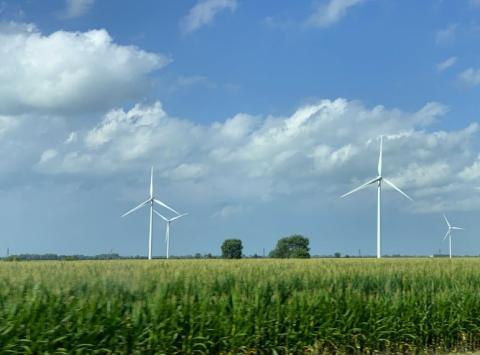Online Technical Training Blog

What to Expect in the Wind Turbine Technician Program: An Overview of the Curriculum and Key Learning Areas
A career as a wind turbine technician isn’t for everyone. It requires a passion for outdoor work, the ability to work at heights, and a solid understanding of how these complex systems operate. While education is not the only path into the field, it can be a valuable step in gaining the technical skills and knowledge needed to install, maintain, and repair wind turbines. George Brown College’s Wind Turbine Technician Certificate Program offers an opportunity to develop these skills, helping prepare individuals for the demands of this growing industry.
The wind power generation industry is experiencing rapid growth. In fact, the global wind energy market is expected to reach $127 billion by 2027, with demand for skilled technicians rising alongside this growth. This article will explore what’s covered in our Wind Turbine Technician Certificate Program and the key competencies students will develop to succeed in this thriving field.
Program Structure
The fully remote Wind Turbine Technician Certificate Program consists of 14 modules designed to accommodate full- or part-time workers. Students study at their own pace, with most completing the program in six months or less.
A key component of the program is the use of advanced simulation software, which bridges the gap between theory and hands-on experience. This software transforms abstract concepts into concrete, interactive examples, helping students visualize how wind turbines operate in real-world conditions.
Students begin with 3DLab Circuit Simulation, which introduces basic AC/DC circuits and virtual instruments like oscilloscopes and multimeters. As they progress, they use CircuitLogix for advanced circuit analysis and PLCLogix 500, which emulates real-world PLC operations, including turbine control systems. These tools allow students to design, test, and troubleshoot electrical and control circuits in a safe, cost-effective virtual environment.
To access the course and simulation tools, students must provide a Windows-based computer.
What Students Learn
This course is going to grab the attention of anyone interested in mechanisms, power generation, and electrical machines. On completion, students will know how to stay safe around wind turbines, how to diagnose problems, and how to carry out repair and maintenance work.
The program provides a comprehensive overview of wind turbine technology, focusing on key areas such as the different types of wind turbines, safety hazards, and how wind energy is harnessed. You'll also explore essential concepts like wind shear, wind gradient, and the role of a ring electrode in wind turbine systems.
In addition to this foundational knowledge, the program delves into electrical systems and electronics, starting with basic electrical concepts such as current, voltage, resistance, capacitance, and inductance. You’ll learn how to assess the efficiency of electrical devices and dive into both DC and AC electricity, including circuit types, transformers, and the effects of inductive and capacitive reactance. You'll also gain insights into power electronics, including solid-state rectifiers, inverters, and converters used in high-power wind turbine circuits.
The program further covers the fundamentals of transformers, motors, and generators, along with electrical codes, reading blueprints, and interpreting mechanical and electrical schematics, with a focus on the National Electrical Code (NEC) and its relevance in the wind turbine industry.
Following the electrical systems foundation, students also study mechanical and hydraulic systems, sensors for monitoring and communication, programmable logic controllers (PLCs), wind farms, and Supervisory Control and Data Acquisition (SCADA) systems. Each section concludes with a 90-minute exam, with a passing grade of 60% or more required to proceed.
Student Support
Studying online offers flexibility and convenience, allowing you to learn at your own pace, but you’re never alone in the process. The program provides continuous support through dedicated discussion forums and a Student Support Center. In the forums, you can easily reach out to online tutors for personalized help, interact with fellow students to exchange ideas and experiences, and access a range of tutorials and helpful resources. With these tools, you'll have the support you need every step of the way.
The Student Support Center is available by phone and email seven days a week, offering extended hours Monday to Friday (9 AM – 11 PM) and weekend support on Saturday and Sunday (10 AM – 5 PM).
Interested? Here are Your Next Steps
Wind energy is an increasingly important source of electrical power, and wind farms are spreading across North America and along the coasts. Qualified Wind Turbine Technicians will be much sought after for years to come, and will be kept busy installing, servicing and maintaining these complex systems. Wind Turbine Technician Certificate provides a path into this fascinating career. For more information, check out George Brown College’s Wind Turbine Technician program or call 1-888-553-5333 to speak with a Program Consultant.


